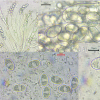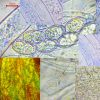
10-09-2025 23:53
 Marcel Heyligen
Marcel Heyligen
Found on Robinia pseudoacasia together with Diapor

11-09-2025 16:57
Our revision of Marthamycetales (Leotiomycetes) is

10-09-2025 17:18
 Blasco Rafael
Blasco Rafael
Hola, encontre este estiercol de vaca estos apotec

02-09-2025 11:34
Thomas Læssøehttps://svampe.databasen.org/observations/10527903

03-09-2025 21:59
Philippe PELLICIERLa Léchère, Col de la Madeleine, alt 1970m, au s

07-09-2025 11:34
 Zuzana Sochorová (Egertová)
Zuzana Sochorová (Egertová)
Hello,I have identified this fungus as Hymenoscyph
Iodophanus hyperboreus?
Lothar Krieglsteiner,
02-08-2024 10:07
 .. found in the French Alps, 5.7.24, 1455 m NN, two quite large apothecia (about 2-3 mm) with beautiful rosy-pink tint growing on a very strongly decayed and water-soaked piece of wood lying in a fountain situation between mosses like Cratoneuron commutatum and Philonotis fontana, wet situation (in the surrounding nearly every habitat was fully dried out). The nitrogen-level was low which is indicated already by the mosses, and by spermatophytes (e.g. Parnassia palustris, Pinguicula vulgaris not far away).
.. found in the French Alps, 5.7.24, 1455 m NN, two quite large apothecia (about 2-3 mm) with beautiful rosy-pink tint growing on a very strongly decayed and water-soaked piece of wood lying in a fountain situation between mosses like Cratoneuron commutatum and Philonotis fontana, wet situation (in the surrounding nearly every habitat was fully dried out). The nitrogen-level was low which is indicated already by the mosses, and by spermatophytes (e.g. Parnassia palustris, Pinguicula vulgaris not far away).The sea level is perhaps a bit low, but I think I. hyperboreus should be a better choice than I. testaceus. I measured the spores with about 19-21/11,5-13 µm. My cotton blue stain was not very good working, maybe because of the very wet water-soaked material. The spores were finely warty . The paraphyses are perhaps distinctive, too - they are swollen and strongly guttulate.
Can I. hyperboreus be confirmed or am I fully on a wrong road?
Best regards, Lothar
Nicolas VAN VOOREN,
02-08-2024 15:45

Re : Iodophanus hyperboreus?
Why not simply I. carneus? It usually grows on dungs, but on a decaying substrate it might be possible...
To my knowledge, I. hyperboreus is terrestrial and has smaller ascospores.
To my knowledge, I. hyperboreus is terrestrial and has smaller ascospores.
Lothar Krieglsteiner,
02-08-2024 15:55

Re : Iodophanus hyperboreus?
Hello Nicolas,
thanks for your opinion.
But ....
Medardi & al. 2006 for his new species hyperboreus: Sp 18-23/10-12 µm
In his key he gives for I. carneus measures of 17-19/10-11,5 and for I. testaceus 17,5-22,5/10,5-14,5
In Prokhorov 1997 I find for I. carneus 15-20/10-12, and for I. testaceus 18-22,5/12-13,5
My measures were (I repeat): 19-21/11,5-13
.
Wood (stronly decayed) or not wood is in my eyes less important than the nitrogen situation (carenus and testaceus are known as strong nitrophytes, and so I always found them before), I. hyperboreus grows at wet (and cold - ... yes) that are nitrogen-poor. I think the ecology is more like my find than that of carneus/testaceus.
Best regards, Lothar
thanks for your opinion.
But ....
Medardi & al. 2006 for his new species hyperboreus: Sp 18-23/10-12 µm
In his key he gives for I. carneus measures of 17-19/10-11,5 and for I. testaceus 17,5-22,5/10,5-14,5
In Prokhorov 1997 I find for I. carneus 15-20/10-12, and for I. testaceus 18-22,5/12-13,5
My measures were (I repeat): 19-21/11,5-13
.
Wood (stronly decayed) or not wood is in my eyes less important than the nitrogen situation (carenus and testaceus are known as strong nitrophytes, and so I always found them before), I. hyperboreus grows at wet (and cold - ... yes) that are nitrogen-poor. I think the ecology is more like my find than that of carneus/testaceus.
Best regards, Lothar





